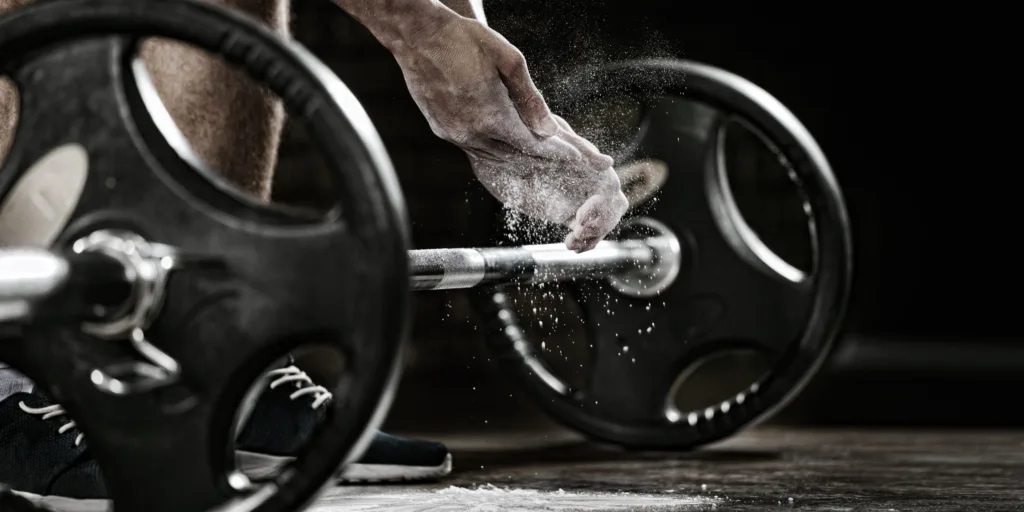Contents
- Summary
- What is ballistic training?
- Why is ballistic training important for sport?
- What do you need to know before starting ballistic training?
- Is future research needed with ballistic training?
- Conclusion
- References
Summary
Ballistic training involves the use of jumps, throws, or strikes to continually accelerate throughout the concentric action, and should not be confused with plyometrics.
This form of training can be used with light, moderate, and/or heavy loads and it seems it is the intent to move quickly, rather than the actual velocity of the load, that is the driving force behind neural adaptations such as increased motor-unit recruitment, rate of force development, and intra- and inter-muscular coordination.
As ballistic exercises have an inherent level of risk and may be performed with high loads (e.g. ~ 90 % one-repetition maximum [1RM]), care should be taken to make sure that they are coached effectively and only undertaken after prior periods of traditional strength training.
Despite extensive research, it remains unclear whether utilising a single load to optimise peak power or a range of loads to develop power across the force-velocity curve is more effective at improving athletic performance.

What is ballistic training?
The term ballistic refers to a method of training, where the athlete’s body or an external object is explosively projected into a flight phase [31] and can, therefore, include exercises such as jumps, throws, or strikes. Unlike traditional lifting techniques – where heavy loads are used to improve neuromuscular power through improved force production – with ballistic training, the load is manipulated in order to train the velocity end of the spectrum [47].
This style of training has also been called dynamic or explosive training; however, both of these terms are inappropriate as the term dynamic can be applied to any exercise that involves movement (i.e. not isometric) and athletes can apply explosive force during early parts of an exercise but reduce the effort near the end [16].
Many studies have highlighted a problem with traditional weight training for power development [6, 15, 17, 48, 51]. Because the athlete must slow the load to a complete stop, there must be a deceleration during a considerable portion of the exercise [16].
Depending on the load being lifted, this deceleration can range from 24-52 % of the concentric phase [15, 35] and results from reduced activation of the agonists accompanied by considerable activation of the antagonists. The deceleration portion is greater when using lighter weights and attempting to move quickly and is therefore undesirable when attempting to maximise explosive performance [34]. However, ballistic training avoids this problem by allowing the athlete to continue to accelerate through the entirety of the movement [16].
Although similar, ballistic training should not be confused with plyometrics, which encompasses an eccentric pre-stretching, followed by a rapid rebound [14]; thereby benefitting from the power-amplifying effect of the muscle-tendon unit known as the stretch-shortening cycle [23].
Despite there being some crossover between the training styles (i.e. certain exercises could be classed as either ballistic or plyometric), ballistic exercises are typically concentric only in nature, meaning the lowering or yielding phase of an exercise is removed. This allows more time to produce force, meaning larger loads (e.g. up to 90 % 1RM) can be utilised [16].
Because of these differences, plyometric and ballistic training develop neuromuscular power via different mechanisms. Plyometrics improves the storage and utilisation of elastic energy, interactions of contractile and elastic elements, potentiation of contractile and elastic filaments, as well as stretch reflexes [11]. Whereas ballistic training improves neural factors including motor-unit recruitment [40], firing frequency, and intra- and inter-muscular coordination [11, 47].
Olympic lifting derivatives [3], bench throws [8, 31], and jump squats [45] are all excellent examples of ballistic training exercises.

Why is ballistic training important for sport?
Power, defined as the ability to express high levels of force in short periods of time [25, 32], encompasses movements such as pedalling, sprinting, jumping, changing direction, pushing, pulling, throwing, and kicking and therefore applies to the vast majority of sports [11, 21].
Increased power output has been shown to be the discriminating factor between participation levels in many sports, including track sprint cycling [28], rugby union [4], rugby league [18, 19], netball [46], taekwondo [20], ice hockey [7], and American football [22]. Although power itself is not a measure of sporting ability, it is believed to represent characteristics of athletic performance [4, 11].
It has been suggested that maximal strength, usually developed by utilising traditional lifting methods, is the most important factor influencing power production [12, 33, 43, 44] and is strongly correlated to athletic activities such as sprinting [29], jumping [27], and throwing [53]. However, as athletes become stronger and more experienced, it seems that more complex and specific methods of training are necessary [11, 47].
The relationship between force and velocity is well documented in the development and maintenance of neuromuscular power [11, 30], where strength qualities across the force-velocity curve can be assessed using techniques such as strength diagnosis [33] or the dynamic strength index [50].
Ballistic exercises, which inherently require increased velocity, have been shown to produce greater force, power output [17, 39], and motor-unit recruitment [40, 43] when compared to traditional, non-ballistic alternatives. In addition to this, the nature of ballistic training means that, unlike plyometrics, a greater range of loads can be used (e.g. 0-90 % 1RM). Consequently, practitioners can manipulate the loads to train specific strength qualities [33, 47].
Further to this, ballistic training is theorised to produce a higher rate of force development (RFD) [47]. The importance of RFD has become more apparent in recent years, as researchers have argued that the ability to achieve maximum force production rapidly may be of greater importance than the actual levels of force achieved [1, 42, 43] and therefore improves sports performance by developing the explosive strength and acceleration capabilities of athletes [42, 49].
Additionally, as ballistic training has also been shown to enhance intra- and inter-muscular coordination [11, 47], its use may improve dynamic correspondence thereby further increasing its effectiveness.
What do you need to know before starting ballistic training?
Though ballistic training is a very effective training method for improving athleticism and sports performance, there are several important issues practitioners must take into consideration before prescribing this modality to athletes.
Optimal Load
The resistance used for ballistic training causes specific changes to the force-velocity relationship, which then changes the degree to which power output is improved [9, 16]. Several studies have asserted that training with a load that maximises power output is more effective at improving power production and athletic performance than either lighter or heavier loading conditions [2, 25, 26, 41]. This has, therefore, been termed the “optimal load”.
Despite several studies demonstrating optimal loads, however, a meta-analysis of the literature proves inconclusive. Depending on the exercise performed and measurement method, as well as the gender, previous strength level, and training history of the subjects, loads ranging from 0-80 % 1RM have been identified as “optimal” [10]. Furthermore, in a study by Cronin et al. (2001) [13], loads ranging from 40-70 % 1RM were found to be similarly effective.
Many sports require powerful actions with a range of loads. For example, sprint cyclists must overcome heavy loads as they attempt to drive the bike off the start line as quickly as possible, but, once the bike is up to speed, the resistances are low [36]. Similarly, rugby union players may have to exert large forces quickly during a scrummage [38] but may have to also produce power at low loads when performing activities such as sprinting, passing, or kicking [30]. For ballistic training then, there is perhaps no “optimal” intensity or resistance.
Both heavy and light intensities have applications in the training of muscular power [16]; therefore, a variety of loads should be used in an organised fashion to elicit superior power outputs across the force-velocity curve.

Intent
Given that ballistic training concentrates on the velocity of the load, it is the intent to lift the load as fast as possible that seems to be the mechanism by which neurological and physiological adaptations occur. Therefore, heavy resistance is effective at increasing power if the athlete attempts to move the load as quickly as possible, even if the actual movement speed is slow [5].
For example, the ballistic actions of weightlifting (e.g. snatch, clean and jerk, etc.), which requires a high level of intent to produce the high force and RFD magnitudes needed to lift the weight, have been shown to recruit larger motor units than endurance-based tasks which require lower-levels of intent [40]; thus raising the potential for positive power adaptations [43].
The problem then is how to measure intent. One method that has increased in popularity in recent years is velocity-based training (VBT), whereby a variety of parameters, including peak and mean velocity can be measured [24]. The real-time feedback available with many VBT systems appeals to the intrinsic competitiveness of the majority of athletes, who inherently want to be the fastest and most explosive in their training group.
Another technique ensuring high levels of intent, even at submaximal loads, is the use of velocity loss as a method of performance regulation [37]. For example, an athlete performs jump squats with an initial velocity of 1.0 metres per second (m/s) and must continue to perform repetitions until the velocity falls below 0.9 m/s (i.e. a 10 % velocity loss). Modest velocity losses (e.g. 10-15 %) are recommended during ballistic training to ensure that the exercises stress the central nervous system and minimise peripheral fatigue [52].
Safety
Although the use of ballistic training methods for improving the athletic capabilities of athletes is highly effective, the high eccentric forces experienced by the athlete when landing from a jump or catching a falling weight may pose a safety concern, especially if larger loads are being used.
Coaches are encouraged to remember that ballistic training is an advanced method of training and the most effective method of developing power in novice athletes is to first develop high levels of strength [12, 33, 43, 44].
Once this has been achieved, practitioners should plan and periodise preparatory phases for ballistic training, ensuring that it progresses gradually from unloaded (e.g. bodyweight or less) to loaded conditions [16].
In addition, the use of some of the VBT methods mentioned above ensures that peripheral fatigue is kept to a minimum [52], thereby reducing the likelihood of an athlete losing control of the weight. Furthermore, specialised training equipment, such as ballistic braking systems [35], can help reduce eccentric resistance.

Is future research needed with ballistic training?
Despite the popularity of ballistic training in applied settings, and given the amount of research that has already been performed on this training methodology, there are still many questions yet to be answered.
As mentioned above, training with a variety of loads may improve power across a larger portion of the force-velocity curve, yet it remains unclear how this affects maximal power output. More research is needed which focuses on the differences between volume-matched single- versus multiple-load ballistic training programmes.
Furthermore, although ballistic training has been shown to elicit positive training outcomes, the dose-response relationship between this form of training and the various neurological and physiological adaptations is not well-known. Longitudinal studies comparing interventions of differing lengths and periodisation styles may help answer these questions.
Conclusion
Like plyometrics, ballistic training takes advantage of the stretch-shorten cycle to develop power. However, ballistic training emphasises the intent, velocity and continued acceleration of the concentric phase of exercises, rather than the storage and utilisation of elastic energy to improve the athletic capabilities of athletes.
As such, a range of loads can be used so that power, rate of force development, and motor-unit recruitment, as well as intra- and inter-muscular coordination, can be developed across the force-velocity curve. These factors may enhance the dynamic correspondence of this method of training.
Landing and catching heavy loads cause an inherent risk, and as such, practitioners should ensure ballistic programmes are planned properly, working from unloaded to loaded, and only undertaken after adequate strength levels have been achieved.
- Aagaard, P, Simonsen, E., Andersen, J., Magnusson, S., and Dyhre-Poulsen, P. Increased rate of force development and neural drive of human skeletal muscle following resistance training. J Appl Physiol 93: 1318–1326, 2002. https://www.ncbi.nlm.nih.gov/pubmed/12235031
- Alcaraz, PE, Palao, JM, and Elvira, JLL. Determining the optimal load for resisted sprint training with sled towing. J Strength Cond Res 23: 480–485, 2009. https://www.ncbi.nlm.nih.gov/pubmed/19197200
- Arabatzi, F, Kellis, E, and De Villarreal, ES. Vertical jump biomechanics after plyometric, weight lifting, and combined (weight lifting+ plyometric) training. J Strength Cond Res 24: 2440–2448, 2010.Available from: http://journals.lww.com/nsca-jscr/Abstract/2010/09000/Vertical_Jump_Biomechanics_after_Plyometric,.24.aspx
- Argus, CK, Gill, ND, and Keogh, JWL. Characterization of the differences in strength and power between different levels of competition in rugby union athletes. J Strength Cond Res 26: 2698–2704, 2012. https://www.ncbi.nlm.nih.gov/pubmed/22105055
- Behm, DG and Sale, DG. Intended rather than actual movement velocity determines velocity-specific training response. J Appl Physiol 74: 359–368, 1993. https://www.ncbi.nlm.nih.gov/pubmed/8444715
- Berger, RA. Effects of dynamic and static training on vertical jumping ability. Res Q Am Assoc Health Phys Educ Recreat 34: 419–424, 1963. https://www.tandfonline.com/doi/abs/10.1080/10671188.1963.10613253?journalCode=urqe17
- Burr, JF, Jamnik, VK, Dogra, S, and Gledhill, N. Evaluation of jump protocols to assess leg power and predict hockey playing potential. J Strength Cond Res 21: 1139–1145, 2007. https://www.ncbi.nlm.nih.gov/pubmed/18076264
- Clark, RA, Bryant, AL, and Humphries, B. A comparison of force curve profiles between the bench press and ballistic bench throws. J Strength Cond Res 22: 1755–1759, 2008. https://www.ncbi.nlm.nih.gov/pubmed/18978630
- Cormie, P and Flanagan, SP. Does an optimal load exist for power training? Strength Cond J 30: 67, 2008. https://www.researchgate.net/publication/49277525_Does_an_Optimal_Load_Exist_for_Power_Training
- Cormie, P, McCaulley, GO, Triplett, NT, and McBride, JM. Optimal loading for maximal power output during lower-body resistance exercises. Med Sci Sports Exerc 39: 340–349, 2007.Available from: http://content.wkhealth.com/linkback/openurl?sid=WKPTLP:landingpage&an=00005768-200702000-00017
- Cormie, P, McGuigan, MR, and Newton, RU. Developing maximal neuromuscular power: Part 1 biological basis of maximal power production. Sports Med 41: 17–38, 2011. https://www.ncbi.nlm.nih.gov/pubmed/21142282
- Cormie, P, McGuigan, MR, and Newton, RU. Developing maximal neuromuscular power: Part 2 training considerations for improving maximal power production. Sports Med 41: 125–146, 2011. https://www.ncbi.nlm.nih.gov/pubmed/21244105
- Cronin, JB, McNair, PJ, and Marshall, RN. Developing explosive power: a comparison of technique and training. J Sci Med Sport 4: 59–70, 2001. https://www.ncbi.nlm.nih.gov/pubmed/11339494
- Davies, G, Riemann, BL, and Manske, R. Current concepts of plyometric exercise. Int J Sports Phys Ther 10: 760–786, 2015.Available from: https://www.ncbi.nlm.nih.gov/pmc/articles/PMC4637913/
- Elliott, BC, Wilson, GJ, and Kerr, GK. A biomechanical analysis of the sticking region in the bench press. Med Sci Sports Exerc 21: 450–462, 1989. https://www.ncbi.nlm.nih.gov/pubmed/2779404
- Fleck, SJ and Kraemer, WJ. Designing Resistance Training Programs, 4E. Human Kinetics, 2014. https://us.humankinetics.com/products/designing-resistance-training-programs-4th-edition-pdf
- Frost, DM, Cronin, JB, and Newton, RU. Have we underestimated the kinematic and kinetic benefits of non-ballistic motion? Sports Biomech 7: 372–385, 2008. https://www.ncbi.nlm.nih.gov/pubmed/18972886
- Gabbett, TJ and Seibold, AJ. Relationship between tests of physical qualities, team selection, and physical match performance in semiprofessional rugby league players. J Strength Cond Res 27: 3259–3265, 2013.Available from: http://journals.lww.com/nsca-jscr/Abstract/2013/12000/Relationship_Between_Tests_of_Physical_Qualities,.5.aspx
- Gabbett, TJ, Stein, JG, Kemp, JG, and Lorenzen, C. Relationship between tests of physical qualities and physical match performance in elite rugby league players. J Strength Cond Res 27: 1539–1545, 2013. https://www.ncbi.nlm.nih.gov/pubmed/23037614
- Giroux, C, Rabita, G, Chollet, D, and Guilhem, G. Optimal balance between force and velocity differs among world-class athletes. J Appl Biomech , 2015. https://www.ncbi.nlm.nih.gov/pubmed/26398964
- Haff, G. and Nimphius, S. Training principles for power. Strength Cond J 34: 2–12, 2012.Available from: http://journals.lww.com/nsca-scj/Abstract/2012/12000/Training_Principles_for_Power.2.aspx
- Harris, GR, Stone, MH, O’Bryant, HS, Proulx, CM, and Johnson, RL. Short-term performance effects of high power, high force, or combined weight-training methods. J Strength Cond Res 14: 14–20, 2000.Available from: http://edulife.com.br/dados%5CArtigos%5CEducacao%20Fisica%5CMuscula%C3%A7%C3%A3o%20e%20Condicionamento%20Fisico%5CCombined%20Weight-Training.pdf
- Ishikawa, M. Muscle-tendon interaction and elastic energy usage in human walking. J Appl Physiol 99: 603–608, 2005.Available from: http://jap.physiology.org/cgi/doi/10.1152/japplphysiol.00189.2005
- Jovanovic, M and Flanagan, E. Researched applications of velocity based strength training. J Aust Strength Cond 22: 58–69, 2014.Available from: http://search.ebscohost.com/login.aspx?direct=true&db=s3h&AN=96676186&site=ehost-live
- Kawamori, N and Haff, GG. The optimal training load for the development of muscular power. J Strength Cond Res 18: 675–684, 2004. https://www.ncbi.nlm.nih.gov/pubmed/15320680
- Kilduff, LP, Bevan, H, Owen, N, Kingsley, MIC, Bunce, P, Bennett, M, et al. Optimal loading for peak power output during the hang power clean in professional rugby players. Int J Sports Physiol Perform 2: 260–269, 2007. https://www.ncbi.nlm.nih.gov/pubmed/19168926
- Kraska, JM, Ramsey, MW, Haff, GG, Fethke, N, Sands, WA, Stone, ME, et al. Relationship between strength characteristics and unweighted and weighted vertical jump height. Int J Sports Physiol Perform 4: 461–473, 2009. https://www.ncbi.nlm.nih.gov/pubmed/20029097
- Martin, JC, Davidson, CJ, and Pardyjak, ER. Understanding sprint-cycling performance: the integration of muscle power, resistance, and modeling. Int J Sports Physiol Perform 2: 5, 2007.Available from: http://www.wisil.recumbents.com/wisil/MartinDocs/Sprint%20cycling%20performance%20review.pdf
- McBride, JM, Nimphius, S, and Erickson, TM. The acute effects of heavy-load squats and loaded countermovement jumps on sprint performance. J Strength Cond Res 19: 893–897, 2005. https://www.ncbi.nlm.nih.gov/pubmed/16287357
- McMaster, DT, Gill, ND, Cronin, JB, and McGuigan, MR. Force-Velocity-Power Assessment in Semi-Professional Rugby Union Players. J Strength Cond Res Natl Strength Cond Assoc , 2016. https://www.ncbi.nlm.nih.gov/pubmed/23838968
- Moir, GL, Munford, SN, Moroski, LL, and Davis, SE. The effects of ballistic and non-ballistic bench press on mechanical variables. J Strength Cond Res , 2017. https://www.ncbi.nlm.nih.gov/pubmed/28225524
- Newton, R. and Kraemer, W. Developing explosive muscular power: implications for a mixed methods training strategy. Strength Cond J 16: 20–31, 1994. https://journals.lww.com/nsca-scj/Citation/1994/10000/Developing_Explosive_Muscular_Power__Implications.2.aspx
- Newton, RU and Dugan, E. Application of strength diagnosis. Strength Cond J 24: 50, 2002. https://journals.lww.com/nsca-scj/Citation/2002/10000/Application_of_Strength_Diagnosis.14.aspx
- Newton, RU, Humphries, B, Murphy, A, Wilson, GJ, and Kraemer, WJ. Biomechanics and neural activation during fast bench press movements: Implications for power training. In: NSCA Conference, New Orleans.1994. https://books.google.co.uk/books?id=rk3SX8G5Qp0C&pg=PA622&lpg=PA622&dq=Newton,+RU,+Humphries,+B,+Murphy,+A,+Wilson,+GJ,+and+Kraemer,+WJ.+Biomechanics+and+neural+activation+during+fast+bench+press+movements:+Implications+for+power+training.+In:+NSCA+Conference,+New+Orleans.1994.&source=bl&ots=o7fGnfAdQU&sig=f4xSsm9XsjUstqFEI4jLcaD5-kE&hl=en&sa=X&ved=0ahUKEwin8IX39YTbAhVPSsAKHfXEBwUQ6AEIJzAA
- Newton, RU and Wilson, GJ. Reducing the risk of injury during plyometric training: The effect of dampeners. Res Sports Med Int J 4: 159–165, 1993. http://www.tandfonline.com/doi/pdf/10.1080/15438629309511978
- O’Bryan, SJ, Brown, NAT, Billaut, F, and Rouffet, DM. Changes in muscle coordination and power output during sprint cycling. Neurosci Lett 576: 11–16, 2014.Available from: http://linkinghub.elsevier.com/retrieve/pii/S0304394014003954
- Pareja‐Blanco, F, Rodríguez‐Rosell, D, Sánchez‐Medina, L, Sanchis‐Moysi, J, Dorado, C, Mora‐Custodio, R, et al. Effects of velocity loss during resistance training on athletic performance, strength gains and muscle adaptations. Scand J Med Sci Sports 27: 724–735, 2017.Available from: https://onlinelibrary.wiley.com/doi/abs/10.1111/sms.12678
- Quarrie, KL and Wilson, BD. Force production in the rugby union scrum. J Sports Sci 18: 237–246, 2000. https://www.ncbi.nlm.nih.gov/pubmed/10824640
- Requena, B, García, I, Requena, F, de Villarreal, E.-S, and Cronin, JB. Relationship between traditional and ballistic squat exercise with vertical jumping and maximal sprinting. J Strength Cond Res 25: 2193–2204, 2011. https://www.ncbi.nlm.nih.gov/pubmed/21572354
- Sale, DG. Neural adaptation to resistance training. Med Sci Sports Exerc 20: S135-145, 1988. https://www.ncbi.nlm.nih.gov/pubmed/3057313
- Soriano, MA, Jiménez-Reyes, P, Rhea, MR, and Marín, PJ. The optimal load for maximal power production during lower-body resistance exercises: a meta-analysis. Sports Med , 2015.Available from: http://link.springer.com/10.1007/s40279-015-0341-8
- Stone, MH, Sanborn, K, O’Bryant, HS, Hartman, M, Stone, ME, Proulx, C, et al. Maximum Stength-Power-Performance Relationships in Collegiate Throwers. J Strength Cond Res 17: 739–745, 2003. https://www.ncbi.nlm.nih.gov/pubmed/14636111
- Suchomel, TJ, Nimphius, S, Bellon, CR, and Stone, MH. The importance of muscular strength: Training considerations. Sports Med , 2018.Available from: http://link.springer.com/10.1007/s40279-018-0862-z
- Suchomel, TJ, Nimphius, S, and Stone, MH. The importance of muscular strength in athletic performance. Sports Med 46: 1419–1449, 2016.Available from: http://link.springer.com/10.1007/s40279-016-0486-0
- Suchomel, TJ, Sato, K, DeWeese, BH, Ebben, WP, and Stone, MH. Potentiation effects of half-squats performed in a ballistic or nonballistic manner. J Strength Cond Res 30: 1652–1660, 2016. https://www.ncbi.nlm.nih.gov/pubmed/26544089
- Thomas, C, Comfort, P, Jones, PA, and dos Santos, T. Strength and Conditioning for Netball: A Needs Analysis and Training Recommendations. Strength Cond J 39: 10–21, 2017.Available from: http://journals.lww.com/nsca-scj/Abstract/2017/08000/Strength_and_Conditioning_for_Netball___A_Needs.3.aspx
- Turner, AN. Training for power: Principles and practice. Prof Strength Cond 20–32, 2009. http://eprints.mdx.ac.uk/14640/1/UKSCA_Power.pdf
- Wilson, GJ, Newton, RU, Murphy, AJ, and Humphries, BJ. The optimal training load for the development of dynamic athletic performance. Med Sci Sports Exerc 25: 1279–1286, 1993. https://www.ncbi.nlm.nih.gov/pubmed/8289617
- Winchester, JB, McBride, JM, Maher, MA, Mikat, RP, Allen, BK, Kline, DE, et al. Eight weeks of ballistic exercise improves power independently of changes in strength and muscle fiber type expression. J Strength Cond Res 22: 1728–1734, 2008. https://www.ncbi.nlm.nih.gov/pubmed/18815571
- Young, KP, Haff, GG, Newton, RU, Gabbett, TJ, and Sheppard, JM. Assessment and monitoring of ballistic and maximal upper body strength qualities in athletes. Int J Sports Physiol Perform , 2014. https://www.ncbi.nlm.nih.gov/pubmed/25115146
- Young, WB and Bilby, GE. The effect of voluntary effort to influence speed of contraction on strength, muscular power, and hypertrophy development. J Strength Cond Res 7: 172–178, 1993. https://journals.lww.com/nsca-jscr/abstract/1993/08000/the_effect_of_voluntary_effort_to_influence_speed.9.aspx
- Zając, A, Chalimoniuk, M, Maszczyk, A, Gołaś, A, and Lngfort, J. Central and peripheral fatigue during resistance exercise – a critical review. J Hum Kinet 49: 159–169, 2015.Available from: https://www.ncbi.nlm.nih.gov/pmc/articles/PMC4723165/
- Zaras, N, Spengos, K, Methenitis, S, Papadopoulos, C, Karampatsos, G, Georgiadis, G, et al. Effects of strength vs. ballistic-power training on throwing performance. J Sports Sci Med 12: 130–137, 2013.Available from: https://www.ncbi.nlm.nih.gov/pmc/articles/PMC3761775/




